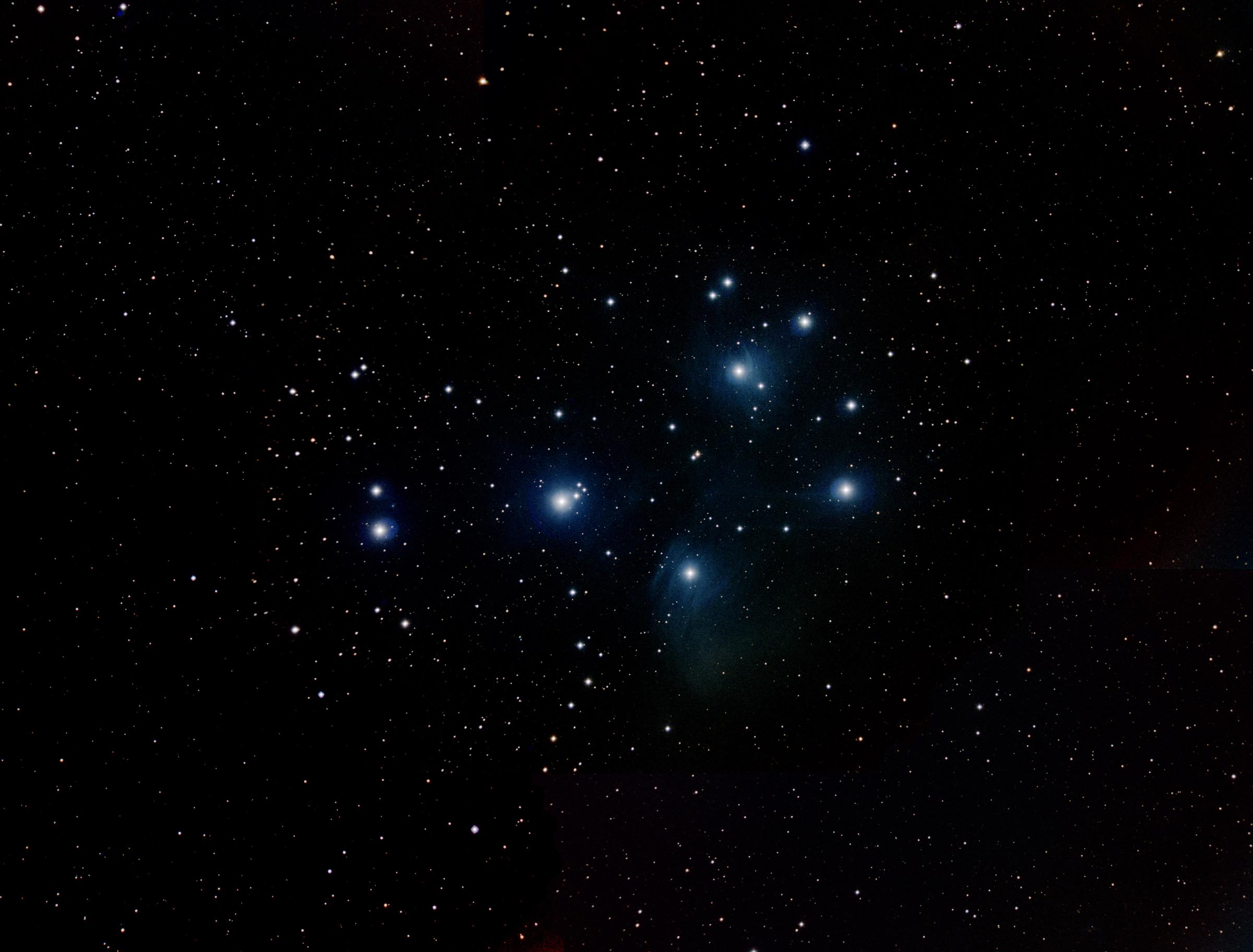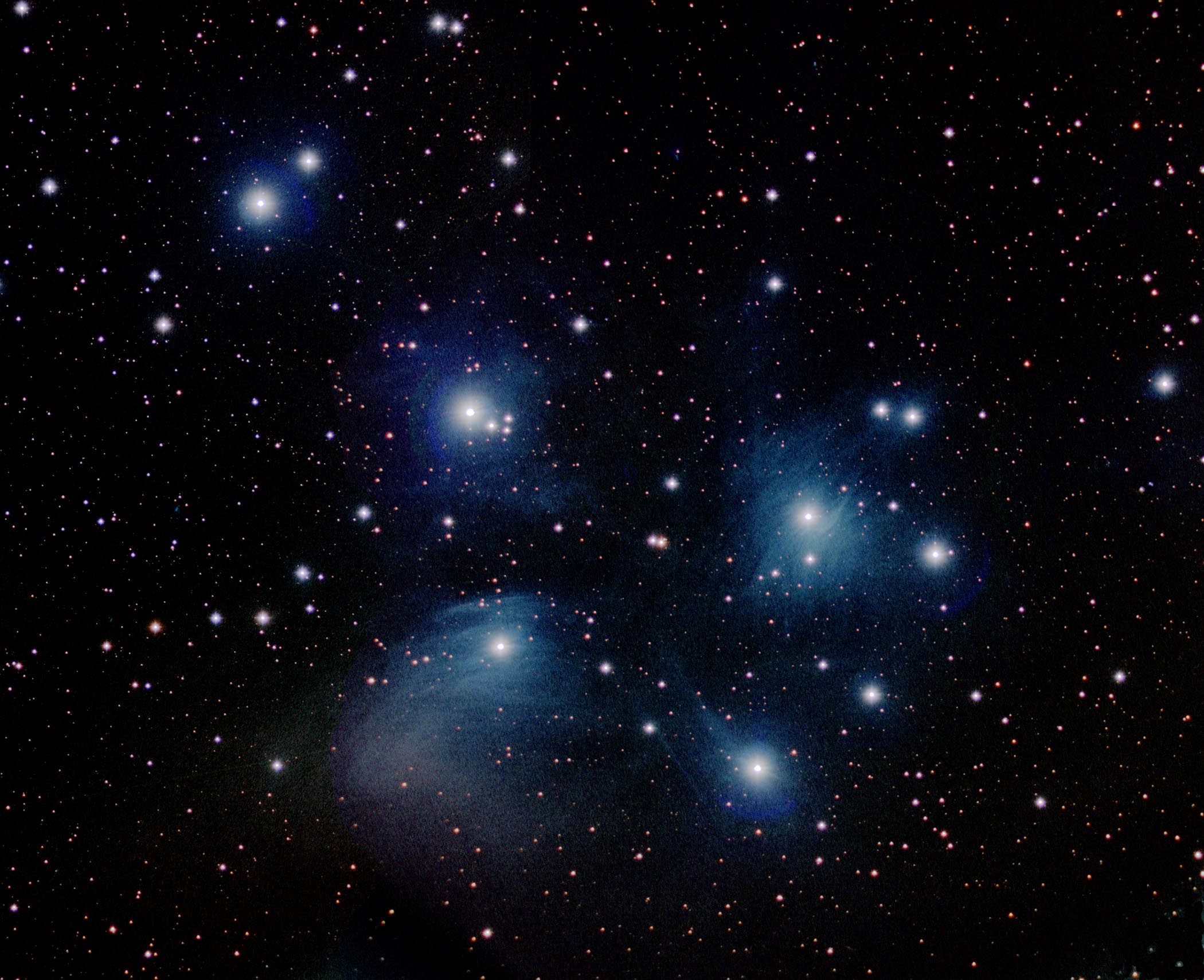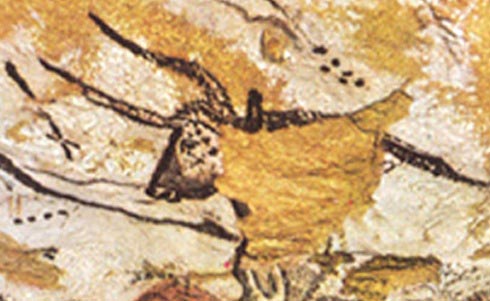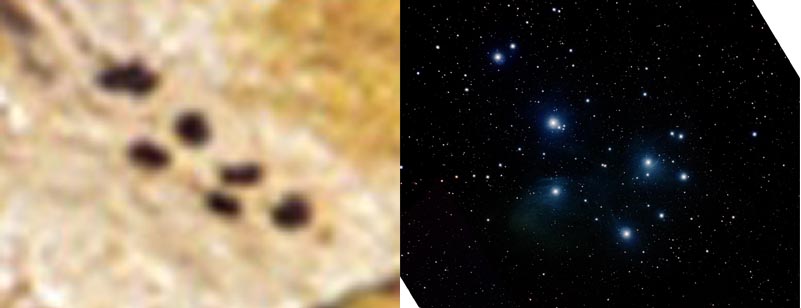
 | SOCO Blog |
14 March 2016
THE PLEIADES
We've been into a long spell of cloudy nights here on the Texas High Plains which has put a definite crimp in acquiring new imagery at SOCO. The last set of imagery I was able to get was back on February 27. As a complement to my previous exercise of producing a mosaic image of the grand open cluster M 44 (the Beehive or Praesepe), I can now present a similar treatment of the other great cluster of antiquity, the Pleiades. While the Pleiades is usually thought of as a fall and winter object, it is still riding quite high in the western sky after dusk this time of the year. To capture it, I used the same approach as with M 44— a mosaic created from five images, with one image containing the center of the cluster and the four others forming the corners around it. Since the main stars in the Pleiades are quite bright (visual magnitudes from 2.86 to around 6), I reduced the exposure time from 90 seconds to 60 seconds for each of the images. The result is presented in Figure 1. In this case, the contrast stretching performed to produce the final image was aimed at emphasizing the stars in the cluster and not the wisps of reflection nebula that surround them (more about that later).

Figure 1. Mosaic image of the Pleiades, M 45.
My image is wide enough to not only show the main group of bright stars but also the halo of numerous smaller stars also making up the cluster. The Pleiades contains over 1000 known member stars. However, the stars most often thought of are those of the Greek myths— the "Seven Sisters". So there won't be any confusion, Figure 2 identifies the Seven Sisters (in order of their brightness, Alcyone, Electra, Maia, Merope, Taygeta, Celaeno, and Sterope) along with their parents Atlas and Pleione. So, in our naked-eye viewing of the Pleiades, Atlas and Pleione stand off to the side while their daughters cluster to the west. Of course, we all know the story of how the Seven Sisters were pursued by the hunter Orion and were transformed by the gods into doves that still fly before him in the night sky. Stories involving the Pleiades abound, and they are mentioned in poetry and literature from around the world and from all ages. The stories are too numerous to cite here— R. H. Allen devotes a full 21 pages of his book, "Star Names, Their Lore and Meaning" (1963, Dover Publications, New York) to the Pleiades.
In Figure 2, note that Sterope consists of two stars, separated by 2.4 arc-min. To the naked eye, it's difficult to separate these two components (designated Sterope1 and Sterope2). Sterope1 (also called Asterope) has a visual magnitude of 5.76 and lies at a distance of 370.6 LY. Sterope2 is dimmer at magnitude 6.43 and lies at a distance of 379.3 LY.

Figure 2. The "Seven Sisters" and their parents— the Pleiades.
One of the features of the Pleiades hinted at in Figure 1 is the presence of a tenuous, wispy reflection nebula within which the star cluster lies. This feature can be better seen in Figure 3, which is an image I acquired back on 28 February 2013 using a 3-minute exposure time. Here, the brighter stars each light up a portion of this nebula. Most prominent is the portion around Merope, which bears the name the Merope Nebula (NGC 1435). Also fairly prominent is the nebulosity around Maia (NGC 1432). It was once thought that this nebula was left over from the formation of the open cluster. Now it is known that this nebula is a part of the large-scale Taurus-Auriga complex of dark dust clouds and the Pleiades are just passing through it. All the brighter stars in the cluster are young spectral class B stars, and the reflection of their blue light gives the nebula its characteristic color. The Pleiades are quite close to us— 425 LY away. This distance is known to be fairly accurate, since the stars of the cluster are close enough to us to measure their distance by parallax. As might be expected from the spectral types of its stars, the Pleiades is very young— only around 100 million years old. It is believed that the cluster will disperse over the next 250 million years due to external gravitational forces.

Figure 3. Longer exposure of the Pleiades showing details of the reflection nebula.
The Pleiades have undoubtedly been viewed as far back in time as man looked up. I'm curious as to the earliest records of their observation. Let's start with the early civilizations of Mesopotamia— the Babylonians and their predecessors the Akkadians and Sumerians. In the MUL.APIN, the Babylonian star guide dated to around 1100-700 BCE, the Pleiades bear the name MUL.MUL. In cuneiform, this would be written
with each stroke of the 8-pointed star created by impressing a wedge-shaped stylus into wet clay. Here, the first "MUL" sign (group of three stars) signifies a "star", which to the Sumerians and Babylonians could indicate a variety of celestial objects, including a star, a planet, or a constellation. The second "MUL" sign would mean "stars", so the literal translation of MUL.MUL would be "star of stars" (keeping in mind that the first "star" in this phrase would mean "group" or "constellation"). MUL.MUL was very important to these early peoples because, at that time, it was close to the Vernal Equinox and marked the first month of their lunar calendar. The Pleiades are also mentioned in the older Babylonian text, the "Prayer to the Gods of the Night" (1830-1530 BCE), and the "Three Stars Each" tablets (before 1100 BCE), which was the predecessor to the MUL.APIN.
Since the Sumerians invented writing, you won't find written accounts of the Pleiades from any other contemporary ancient civilizations. However, there appear to be references to this star cluster in artwork from Bronze Age and earlier Europe. Figure 4 shows the "Nebra Sky Disk", an artifact found in a burial cache near Nebra, Germany, and dated to approximately 1600 BCE. This circular object, with a diameter of approximately 30 cm, depicts a crescent moon and sun (or possibly full moon) surrounded by stars. Most of the stars are randomly located, except for a close grouping of seven located between the crescent moon and the "sun" (or full moon). This feature is believed to represent the Pleiades. There are other interesting astronomically related features on this artifact, but its purpose is unknown (although the row of small holes along its circumference suggest that it might have been attached as the face to a shield— it was found with several swords in the burial cache).

Figure 4. The Nebra Sky Disk.
Attribution: Dbachmann
Artwork in Europe goes back much further in time than the Bronze Age. Some of the best examples of Neolithic artwork can be found in the caves of France and Spain. At various locations in these regions, cave walls are adorned with mignificent full-color paintings of game animals executed by Cro-Magnon artists. A fine example is presented in Figure 5, which shows the front portion of a wild bull (actually, an auroch) from the "Hall of the Bulls" in the Lascaux Cave in Dordogne, France. This painting is thought to be around 20,000 to 30,000 years old. While this painting is incredibly beautiful, what has struck researchers is the cluster of dots lying above the shoulder of the bull.

Figure 5. Wall painting from the "Hall of the Bulls" in the Lascaux Cave in France.
Source: Rhawn Joseph, "Evolution of Paleolithic Cosmology and Spiritual Consciousness, and the Temporal and Frontal Lobes", Journal of Cosmology, 2011, Vol. 14.
An enlarged view of these dots is presented in Figure 6. There appear to be six dots, although the leftmost might itself be a pair of dots painted close enough to be touching— this would give a total of seven dots. The layout of these dots roughly follows the pattern of the seven brightest stars of the Pleiades (Atlas/Pleione, Alcyone, Merope, Maia, Electra, and Taygeta), as indicated in the right side of Figure 6. In addition, the location of the dots relative to the rest of the bull painting is very similar to the classic relationship between the Pleiades and the constellation of Taurus, the Bull, as seen on numerous star charts. For example, compare the cave wall painting in Figure 5 to the representation of Taurus in Figure 7, taken from the set of charts published in 1824 as Urania's Mirror.

Figure 6. (left) Enlarged detail from the painting in Figure 5, (right) the Pleiades.

Figure 7. The constellation Taurus and the Pleiades from Urania's Mirror.
Source: Wikipedia.
So, is the group of dots in the cave wall painting just a coincidental feature, as some have concluded? Or does it show that what we see in the sky today is something that has been handed down through history and pre-history from the earliest days of our existence as thinking beings? The Bull and the Star Cluster appear on the earliest representations of the sky from our Bronze Age ancestors of 2000 BCE— is it unreasonable to think that they got it from earlier sources? Maybe it's just that people have always thought that a certain group of stars looked like the head of a bull. Just like when you show someone the stars of Scorpius and tell them that it supposed to be a scorpion, they usually say, "Yeah, I can see that."
The Pleiades is more than just a great astronomical object— it is something that allows us to see through the eyes of our distant ancestors.
 Return to SOCO Blog Page
Return to SOCO Blog Page
 Return to SOCO Main Page
Return to SOCO Main Page
Questions or comments? Email SOCO@cat-star.org